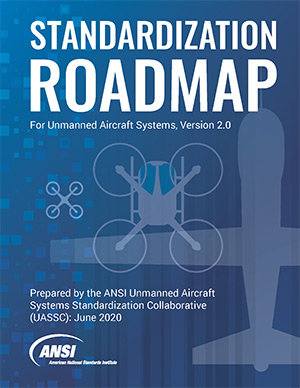The American National Standards Institute (ANSI) has published the Standardization Roadmap for Unmanned Aircraft Systems (Version 2.0). The roadmap was developed by the Institute’s UAS Standardization Collaborative (UASSC), a group established to coordinate and accelerate the development of the standards and conformity assessment programs needed to facilitate the safe integration of UAS into the US national airspace system. More than 400 individuals from 250 public- and private-sector organizations supported the document’s development, including representatives of the Federal Aviation Administration (FAA), other US federal government agencies, standards developing organizations (SDOs), industry, and academia.
A webinar with UASSC leaders providing an overview of the roadmap will be held on July 15 at 12 noon Eastern. Register here
According to a press release issued by ANSI, the release of the updated roadmap represents the culmination of the UASSC’s work over the last nine months to identify existing standards and standards in development, assess gaps, and make recommendations for priority areas where there is a perceived need for additional standardization including pre-standardisation research and development. Issues are addressed under the broad headings of airworthiness; flight operations; personnel training, qualifications, and certification; infrastructure inspections; environmental applications; commercial services; workplace safety; and public safety operations. The document also includes brief overviews of the UAS activities of the FAA, other US federal government agencies, SDOs, and various industry groups.
Ultimately, the aim of the UASSC roadmap is to support the growth of the UAS market with an emphasis on civil, commercial, and public safety applications. While the UASSC does not itself develop standards, its roadmap recommendations are anticipated to see wide adoption by the standards community.
The reason for undertaking the version 2.0 update was to expand the document’s content, engage subject matter experts not previously involved, identify potentially overlooked gaps, track progress by SDOs to address the recommendations contained in version 1.0, review priorities, and otherwise incorporate feedback. Of 78 issue areas examined, 71 open gaps were identified, meaning there is currently no published standard or specification that covers the issue in question. Each gap includes a corresponding recommendation for action, along with a priority level for producing a standard and the name of a suggested organisation(s) that can address the need. Of the open gaps, 47 have been identified as high priority, 21 as medium priority, and 3 as lower priority. In 53 cases, additional research & development is needed. Two version 1.0 gaps were closed, 3 were withdrawn, and 16 new gaps were added.
Many sections of the document were substantially revised or expanded, including such areas as: categories of spectrum applicable to command and control (C2) link and communications, continued operational safety, UAS detection and mitigation, and public safety tactical operations. New gap analysis sections were added related to:
- Blockchain for UAS
- Recreational Operations
- Design and Operation of Aerodrome Facilities for UAS
- UAS Service Suppliers (USS) Process and Quality
- Implementing UAS for Hydrocarbon Pipeline Inspections
- Implementing UAS in Airport Operations
- Commercial Cargo Transport via UAS
- Commercial Passenger Air Taxi/Transport via UAS (both short- and long-haul flights)
- Commercial Sensing Services
- Use of small UAS for News Gathering
- UAS for Emergency Management and Disasters
- Standardization of Data Formatting for small UAS Public Safety Operations
It is envisioned that future work will entail promotion of the roadmap and establishing a mechanism to assess progress on its implementation.
“ANSI extends its thanks and congratulations to all the volunteers who contributed to the development of the updated UASSC roadmap,” said ANSI president and CEO Joe Bhatia. “This latest accomplishment is illustrative of ANSI’s ability to bring together public- and private-sector stakeholders to define standardization needs for emerging technologies and national and global priorities.”
For more information visit:




